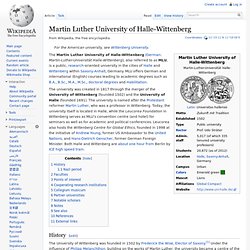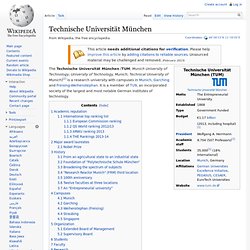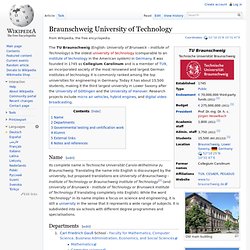

Leipzig University. Leipzig University (German: Universität Leipzig), located in Leipzig in the Free State of Saxony, Germany, is one of the oldest universities in the world and the second-oldest university (by consecutive years of existence) in Germany.

Famous alumni include Leibniz, Goethe, Nietzsche, Wagner, Angela Merkel, Raila Odinga, Tycho Brahe[citation needed] and nine Nobel laureates are associated with this university. The university was founded on December 2, 1409 by Frederick I, Elector of Saxony and his brother William II, Margrave of Meissen, and originally comprised four faculties. Since its inception the university has engaged in teaching and research for over 600 years without interruption. History[edit] Understanding Evolution For Teachers. Text only version. Fyltreesve. Idsv. Evogamesv. EvoGameBoard_PL_sv.png 1 328×3 806 bildpunkter.
Extrabilagan2006_maj. Bioinformatisk_genjakt_1. Kunskapsbanken, Livets utveckling. Darwin for a Day. Vad Darwin inte visste - UR. Allt om Historia. Under en världsomsegling insåg Charles Darwin hur livet på jorden hade utvecklats.

Hans teori om evolutionen var lika enkel som genial, men kastade samtidigt Bibelns skapelseberättelse över ända och mötte hårt motstånd. Text: Anna Larsdotter I augusti 1831 fick Charles Darwin ett brev som skulle förändra hans liv. Avsändare var hans vän John Stevens Henslow, professor i botanik i Cambridge. Av Henslow hade Darwin lärt sig massor om sitt stora intresse: djur och växter.
I brevet frågade Henslow om Darwin ville följa med på en forskningsseglats runt jorden. Så gav sig Charles Robert Darwin den 27 december 1831 av på sitt livs resa. Darwin växte upp med en äldre bror och fyra systrar. Charles Darwin var inte av riktigt samma skrot och korn som sin far och farfar. Han hade lärt sig att stoppa upp djur och byggt upp en imponerande samling skalbaggar.
Darwin fascinerades av de arter han hittade på ögruppen. Darwins anteckningar från resan med Beagle var fyllda av entusiastiska utrop. NanoTechMap : la carte interactive des nanotechnologies en France. VU SUR LE WEB La société de conseil en stratégie pour l’innovation par les nanotechnologie, NanoThinking a mis en ligne sa "NanoTech Map".

Cette carte interactive permet d’identifier en un clin d’œil les compétences en nanosciences et nanotechnologies présentes en France. "Les nanotechnologies sont profondément multidisciplinaires, à la pointe de la recherche académique et industrielle et sources d’emplois dans de nombreux secteurs industriels", explique Nanothinking. Cette société de conseil en stratégie pour l’innovation par les nanotechnologie propose donc sa NanoTechMap pour "favoriser les synergies indispensables entre ces acteurs et augmenter la visibilité de ce nouvel écosystème".
Elle répertorie ainsi les industriels, start-up, centres de recherche et autres acteurs de l'écosystème, qui peuvent s'ajouter à la carte en quelques clics. Julien Bonnet. Personality disorder. Personality disorders are a class of mental disorders characterised by enduring maladaptive patterns of behavior, cognition and inner experience, exhibited across many contexts and deviating markedly from those accepted by the individual's culture.

These patterns develop early, are inflexible and are associated with significant distress or disability.[1] The definitions may vary some according to other sources.[2][3] Official criteria for diagnosing personality disorders are listed in the Diagnostic and Statistical Manual of Mental Disorders, published by the American Psychiatric Association, and in the mental and behavioral disorders section of the International Statistical Classification of Diseases and Related Health Problems, published by the World Health Organization. The DSM-5 published in 2013 now lists personality disorders in exactly the same way as other mental disorders, rather than on a separate 'axis' as previously.[4] Classification[edit] World Health Organization[edit] Martin Luther University of Halle-Wittenberg. The Martin Luther University of Halle-Wittenberg (German: Martin-Luther-Universität Halle-Wittenberg), also referred to as MLU, is a public, research-oriented university in the cities of Halle and Wittenberg within Saxony-Anhalt, Germany.

MLU offers German and international (English) courses leading to academic degrees such as B.A., B.Sc., M.A., M.Sc., doctoral degrees and Habilitation. The university was created in 1817 through the merger of the University of Wittenberg (founded 1502) and the University of Halle (founded 1691). The university is named after the Protestant reformer Martin Luther, who was a professor in Wittenberg. Today, the university itself is located in Halle, while the Leucorea Foundation in Wittenberg serves as MLU’s convention centre (and hotel) for seminars as well as for academic and political conferences. History[edit] University of Duisburg-Essen. The Founder Duke of the United Duchies of Jülich-Cleves-Berg Duisburg City University The University of Duisburg-Essen (German: Universität Duisburg-Essen) is a public university in Duisburg and Essen, North Rhine-Westphalia, Germany and a member of the newly founded University Alliance Metropolis Ruhr.[4] It was founded in 1654 and re-established on 1 January 2003 as a merger of the Gerhard Mercator University of Duisburg and the University of Essen.

Until 1994 the name of the Gerhard Mercator University was Comprehensive University of Duisburg. With its 12 departments and more than 39,000 students, the University of Duisburg-Essen is among the 10 largest German universities. History[edit] Origins; The University of Duisburg (1555) Its origins date back to the 1555 decision of Duke Wilhelm V von Jülich-Kleve-Berg to create a university for the unified duchies at the Lower Rhine. Only a few decades later the university was in competition with the much better equipped Dutch universities. Leipzig University. Leipzig University. Heidelberg University. Coordinates: Rupert I, Elector Palatine established the university when Heidelberg was the capital of the Electoral Palatinate.

Consequently, it served as a centre for theologians and law experts from throughout the Holy Roman Empire. Matriculation rates declined with the Thirty Years' War, and the university did not overcome its fiscal and intellectual crises until the early 19th century.[7] Subsequently, the institution once again became a hub for independent thinkers, and developed into a "stronghold of humanism",[8] and a centre of democratic thinking.[9] At this time, Heidelberg served as a role model for the implementation of graduate schools at American universities.[10] However, the university lost many of its dissident professors and was marked a NSDAP university during the Nazi era (between 1933 and 1945).
Technical University Munich. The Technische Universität München (TUM; Munich University of Technology; University of Technology, Munich; Technical University of Munich)[2] is a research university with campuses in Munich, Garching and Freising-Weihenstephan.

It is a member of TU9, an incorporated society of the largest and most notable German institutes of technology. Academic reputation[edit] International top ranking list[edit] Faculty of Mechanical Engineering. Braunschweig University of Technology. Old main building Library.

University of Hanover. Main building Leibniz Universität Hannover The University of Hannover[nb 1], officially the Gottfried Wilhelm Leibniz Universität Hannover, short Leibniz Universität Hannover (LUH), is a public university located in Hannover, Germany.

Founded in 1831, it is one of the largest and oldest science and technology universities in Germany.[6] In the 2011/12 school year it enrolled 22,236 students, of which 3,138 were from foreign countries. It has nine faculties which offer 190 full and part degree programs in 38 fields of study.[3] The University is named after Gottfried Wilhelm Leibniz, the 18th century mathematician and philosopher. Dresden University of Technology. University of Tübingen. Eberhard Karls University, Tübingen (German: Eberhard Karls Universität Tübingen, sometimes called the "Eberhardina Carolina") is a public research university located in the city of Tübingen, Baden-Württemberg.
It is one of Germany's most famous and oldest universities, internationally noted in medicine, natural sciences, and the humanities. In the area of German Studies (German: Germanistik) it has been ranked first among all German universities for many years, and is known as a centre for the study of theology and religion. Tübingen is one of five classical "university towns" in Germany; the other four being Marburg, Göttingen, Freiburg and Heidelberg.
The university is associated with some Nobel laureates, especially in the fields of medicine and chemistry. History[edit] Its present name was conferred on it in 1769 by Duke Karl Eugen who appended his first name to that of the founder (Karls being the possessive form of Karl). Bauhaus University, Weimar. The Bauhaus University is a university located in Weimar, Germany and specializes in the artistic and technical fields. Established in 1860 as the Great Ducal Saxon Art School, it gained collegiate status on 3 June 1910. In 1919 the school was renamed Bauhaus by its new director Walter Gropius and it received its present name in 1996. Approximately 4,000 students are enrolled at the university today. German University of Administrative Sciences Speyer. Coordinates: The German University of Administrative Sciences Speyer (Speyer University; German: Deutsche Universität für Verwaltungswissenschaften Speyer, DHV; formerly known as German School of Administrative Sciences), is a national graduate school for administrative sciences and public management located in Speyer, Rhineland-Palatinate, Germany.[1] Founded in 1947 by the French occupational authorities as a grande école, today it is operated under the joint responsibility of both the Federal Republic (Bund) and all 16 German states (Länder).[2] It runs four Master's programs, grants doctoral degrees and habilitations, offers a postgraduate certificate program, and administers programs of executive education.
History[edit] The school was founded in 1947 as École Supérieure d'Administration by the French occupational authorities in order to democratize the German senior civil service. Academic programs[edit] Otto Mayer House. Goethe University Frankfurt. The Goethe University Frankfurt (full German name: Johann Wolfgang Goethe-Universität Frankfurt am Main) is a university which was founded in 1914 as a Citizens' University, which means that, while it was a State university of Prussia, it had been founded and financed by the wealthy and active liberal citizenry of Frankfurt am Main, a unique feature in German university history. It was named in 1932 after one of the most famous natives of Frankfurt, the poet and writer Johann Wolfgang von Goethe. Today, the university has 46,000 students, on 4 major campuses within the city. Humboldt University of Berlin. The Humboldt University of Berlin (German: Humboldt-Universität zu Berlin) is one of Berlin's oldest universities, founded in 1810 as the University of Berlin (Universität zu Berlin) by the liberal Prussian educational reformer and linguist Wilhelm von Humboldt, whose university model has strongly influenced other European and Western universities.
From 1828 it was known as the Frederick William University (Friedrich-Wilhelms-Universität), and later (unofficially) also as the Universität unter den Linden after its location. In 1949, it changed its name to Humboldt-Universität in honour of both its founder Wilhelm and his brother, geographer Alexander von Humboldt. In 2012, the Humboldt University of Berlin was one of eleven German top-universities (also known as elite universities) to win in the German Universities Excellence Initiative, a national competition for universities organized by the German Federal Government.
History[edit] Enlargement[edit] Kaiserslautern University of Technology. The University of Kaiserslautern (German Technische Universität Kaiserslautern) is a research university in Kaiserslautern, Germany. It was founded in 1970 and is organized into 12 faculties. History[edit] Technische Universität Ilmenau.